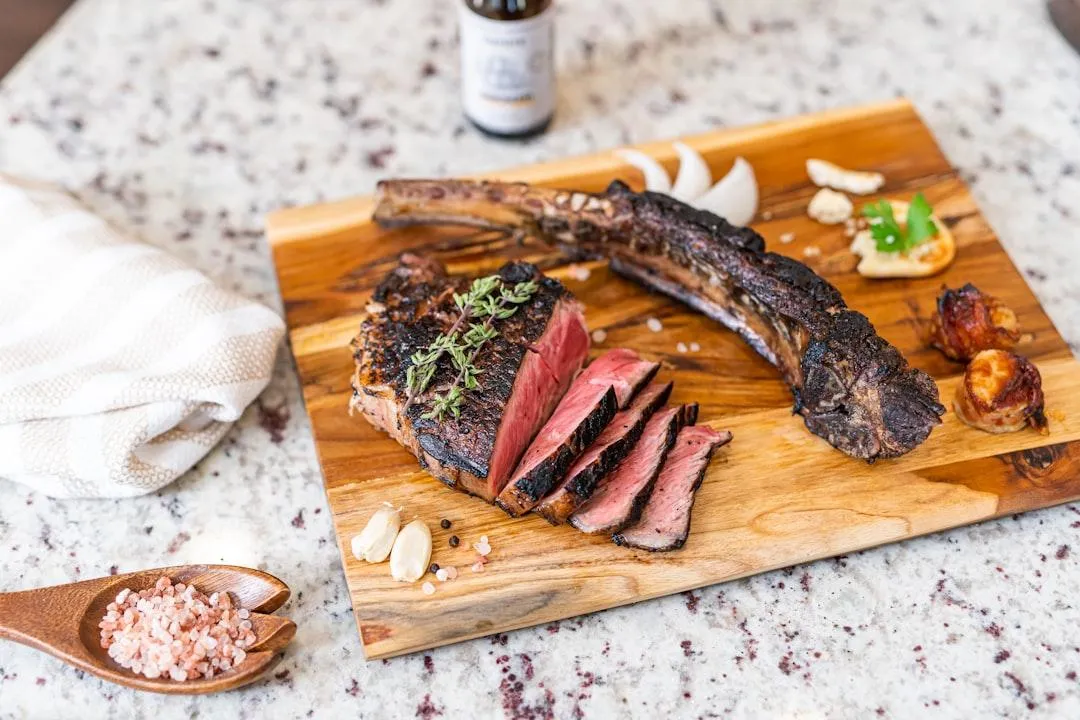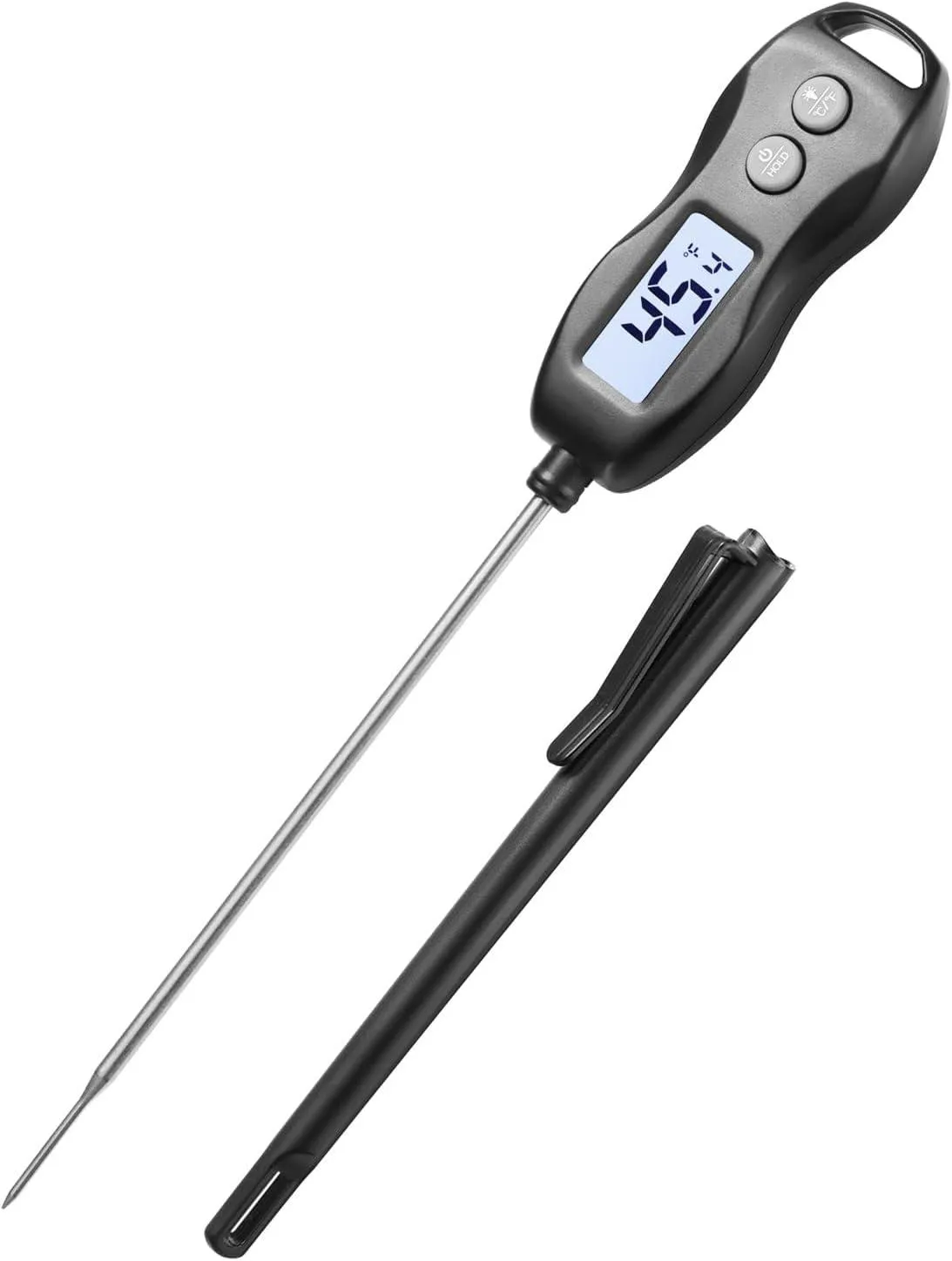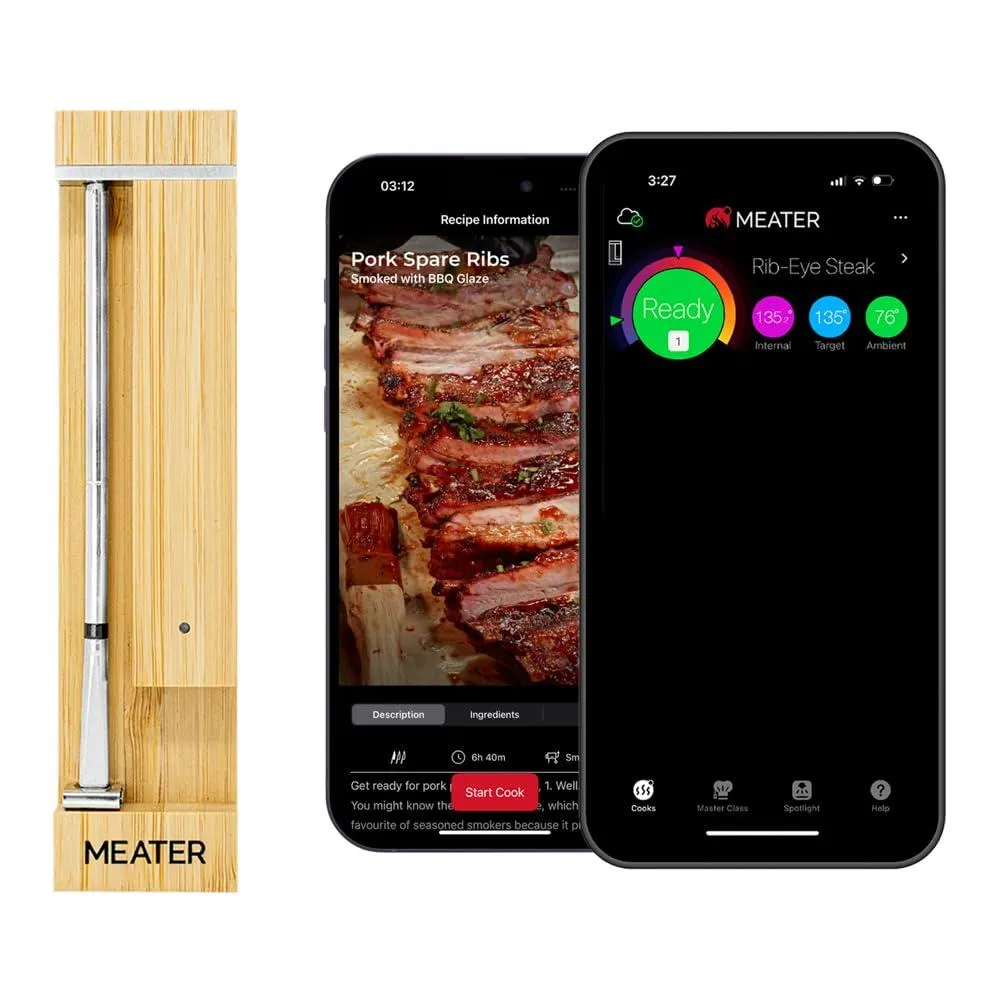Make Your Meat Moist Again
Say goodbye to dry pork chops and hello to perfectly cooked protein.
By CK | Updated on June 19th, 2025

TL;DR
The MEATER Plus is a slick, feature-packed thermometer that a lot of people love—especially if you want live temps on your phone. But honestly? You don’t need it. I’ve been using the ThermoPro TP19H and it’s been solid: fast, accurate, and simple. No app, no drama. Sure, I get a little FOMO when I see folks monitoring their steak from the couch, but when I’m at the grill, one good instant-read thermometer is all I really need.
I love cooking—especially when there’s meat involved. Grilling is kind of my thing. It’s one of our go-to dinners at home. My wife’s into it, the kids are into it, and for me, it’s one of the most satisfying ways to contribute to the meal.
That said, grilling (and smoking) meat isn’t as simple as tossing it on the fire and hoping for the best. Heat zones vary. Some spots on the grill run hot, others stay cooler. You can move things around, sure—but if you lose track of what’s where, things go sideways fast.
One minute you’re sipping a drink, the next you’re chewing through dry steak or rushing back outside because the chicken’s still raw in the middle.
The fix? A thermometer.
It doesn’t matter if you go with a simple instant-read model or a high-tech wireless one that syncs to your phone. Either way, once you start using one, you won’t want to go back.
For longer cooks or smoking sessions, smart thermometers with WiFi are honestly game-changing. You can monitor temps from across the house—or even while running errands. It’s wild.
I’ll admit: I was a holdout. I thought thermometers were for people who didn’t know how to grill. I figured if my ancestors cooked over fire without one, I could too. (Spoiler: I was wrong.)
Have you ever had to work your jaw to chew through a dried-out chicken thigh?
Yeah—same. Once I finally gave in and started using a thermometer, everything changed. Now my meat comes out exactly how I want it—no guessing, no overcooking, no regrets.
I Tried a Few. Here’s What’s Worth Your Money.
Best Overall
ThermoPro TP19H

Best Budget
Digital Meat Thermometer

Spare No Expense
MEATER Pro/2 Plus

The Breakdown
Your Paragraph text goes Lorem ipsum dolor sit amet, consectetur adipisicing elit. Autem dolore, alias, numquam enim ab voluptate id quam harum ducimus cupiditate similique quisquam et deserunt, recusandae. here
Qualities of a great Meat Thermometer
Your Paragraph text goes Lorem ipsum dolor sit amet, consectetur adipisicing elit. Autem dolore, alias, numquam enim ab voluptate id quam harum ducimus cupiditate similique quisquam et deserunt, recusandae. here
Our notes about each product
Your Paragraph text goes Lorem ipsum dolor sit amet, consectetur adipisicing elit. Autem dolore, alias, numquam enim ab voluptate id quam harum ducimus cupiditate similique quisquam et deserunt, recusandae. here
ThermoPro TP19H
I’ve gone through a few meat thermometers over the years—some digital, some old-school analog—and most of them were either slow, confusing, or weirdly hard to read. This one? Honestly, it’s the first one I’ve used that made me feel like I finally “get” why people obsess over good thermometers.
Right out of the box, you notice how fast this thing works. You flip it open, stick it in, and within two seconds, you’ve got a solid temperature reading. I’ve tested it on pork chops, chicken thighs, and a rack of ribs—and every time, the readings were consistent and accurate.
Compared to analog thermometers, this is like upgrading from dial-up to fiber internet. No guessing. No waiting around while the dial creeps toward an answer. You get the info you need before the heat escapes your oven or grill.
I appreciate how user-friendly it is. There’s no setup, no manual needed—just flip it open and it turns on. The display auto-rotates based on how you're holding it, and the digits are large enough that I don't need to squint or tilt it under a light to see.
One thing I really like: the magnetic back. I keep mine stuck right on the side of the fridge, and it stays put. It’s surprisingly handy, especially when your hands are full or you’re juggling a few things at once. Way better than digging through a drawer mid-cook.
Now for the one downside I’ve noticed—while mine feels solid and the fold-out probe clicks nicely into place, I’ve seen others mention the plastic housing can crack if it gets dropped or banged around too much. Personally, I haven’t had any issues, but I don’t toss it around either. If you treat it like a tool and not like a stress ball, you’ll probably be fine.
That said, I wouldn’t give this to a teenager who slams drawers for fun. It feels built well, just maybe not indestructible.
For the price point, I really don’t think you can do much better. It’s quick, easy to use, accurate, and looks like something designed with real kitchen use in mind. If you’re still using an old analog thermometer—or worse, cooking by gut feeling—this is a big step up.
This thermometer doesn’t try to overcomplicate things. It does its job fast, tells the truth, and gets out of the way. That’s exactly what I want in a kitchen tool.
Would I call it the best thermometer I’ve owned? Yes.
Do I think it’s built like a tank? Maybe not, but it’s held up so far.
Would I recommend it to someone cooking their first steak or trying to finally nail the perfect internal temp? Absolutely.
Digital Meat Thermometer
I picked up this thermometer kind of on a whim, but honestly—it turned out to be one of the most useful tools in my kitchen. If you’ve ever hovered over a roast wondering, “Is this actually done or am I about to poison someone?”—this thing is your new best friend.
First off, the accuracy is spot-on. I’ve used it for everything from thick-cut steaks to Thanksgiving turkey, and the readings have always been reliable. You stick it in, and within a few seconds, boom—you’ve got a temperature you can trust. I tested it against my older (and more expensive) thermometer, and this one was just as accurate, if not faster.
During Thanksgiving, I used it to check the thickest part of the turkey breast. It read 165°F in just a couple of seconds, and when I cut in—perfect. Juicy, fully cooked, and no guessing involved. If you’ve ever overcooked a holiday bird out of fear, you know how big of a win that is.
What I love most is how simple it is. No weird buttons or complicated menus—just unfold it, stick it in the meat, and read the temp. The screen is large and backlit, so you can see it clearly even in low light (like those winter evenings when you're grilling in denial that it’s cold out).
There’s also a magnetic back, so I keep mine stuck to the fridge—always handy when I need it fast.
Surprisingly, it’s also come in handy for other things. I’ve used it for making homemade caramel and checking the temp on oil for frying. It’s not marketed as a candy thermometer, but it works just fine if you don’t need a clip-on style. That versatility adds real value, especially for something in this price range.
This isn’t one of those thermometers that costs $80+ and tries to connect to your phone to tell you your meat is medium rare via Bluetooth (why?). It just does the job—and does it well—for a fraction of the price. If you're someone who cooks regularly and wants a dependable, no-nonsense thermometer, this one more than pays for itself.
Would I buy it again? Definitely.
Would I recommend it to a friend? Already have.
Would I trust it with my next holiday meal or a pricey cut of steak? 100%.
It’s accurate, fast, easy to use, and doesn’t try to overdo it with features you don’t need. For the price, it's easily one of the best kitchen tools I've picked up in a long time.
MEATER Pro/2 Plus
Let me start by saying: this thermometer is kind of a show-off. It’s packed with smart features, connects to your phone, handles crazy-high heat, and looks like something designed by NASA. On paper, it’s a meat lover’s dream. And in the right hands, it really can deliver incredible results.
But… that price. And some of the quirks? Let’s talk about it.
User Experience:
The app is clean and intuitive. Setup is simple (when it works—more on that later), and the built-in cook timers are surprisingly accurate. It doesn’t just tell you the internal temp—it estimates how long until your meat is ready, which is super helpful if you're planning a meal or entertaining.
High Heat Performance:
This thing can handle temps up to 1000°F. That means you can use it in a blazing hot cast iron pan, on the grill, in the oven, or even for a prime rib roast without worrying about it frying itself. If you’re cooking at a serious level, this thermometer doesn’t flinch.
Precision Cooking:
When everything is working as it should, you get a really impressive level of control. I used it on a prime rib, and the internal temp tracking was dead on. Pulled it at exactly the right moment, and the result was textbook medium rare. It made me feel like a pro.
Where does it fall short?
Price vs. Practicality:
Here’s the deal—it’s expensive. Easily 3–4x the price of a standard instant-read thermometer. If you cook often, especially premium cuts, it might feel justified. But for the average home cook, it’s probably overkill.
Connectivity Issues:
This was the biggest headache. Sometimes the app just wouldn’t connect. Other times, the probe would randomly drop off and reconnect mid-cook. It’s frustrating when you’re relying on it for timing and suddenly your phone says it lost the signal.
Reliability Is Hit or Miss:
Mine’s worked well overall, but I’ve seen plenty of feedback from others saying it only works some of the time, or starts failing after a few uses. That’s not what you want when you’re trusting it to help you cook a $60 cut of meat.
This is one of those gadgets that feels awesome when it works—and annoying when it doesn’t. If you’re a kitchen tech geek, a frequent griller, or someone who likes impressing dinner guests with perfect timing and presentation, you’ll probably love it (even with the occasional glitch).
But if you're more of a casual cook, or you just want something fast and reliable every time? You might be better off saving the money and going with a solid instant-read model.
Common Questions
Do I really need a meat thermometer?
If you cook meat even occasionally, yes. A good thermometer takes the guesswork out of cooking. No more cutting into your chicken or wondering if your steak is actually medium rare—it just tells you the truth.
What’s the difference between an instant-read thermometer and a leave-in thermometer?
Instant-read thermometers give you a quick temperature reading when you insert them, but they’re not meant to stay in the food while it cooks.
Leave-in thermometers (often digital or smart) are designed to stay in the meat during the entire cook and send live updates to a base or app.
How accurate are digital thermometers?
Most good ones are accurate within 1–2°F, which is plenty precise for cooking. Cheap ones can be off by more—so it's worth investing in a quality brand.
What’s a safe internal temperature for meat?
Here are the USDA-recommended minimums:
Chicken & Turkey: 165°F
Beef, Pork, Lamb (steaks & chops): 145°F
Ground Meats: 160°F
Fish: 145°F
Always rest meat for a few minutes after cooking—it helps the juices settle and the temperature to stabilize.
Can I use a meat thermometer for other things like baking or candy?
Yes—many digital thermometers work for things like bread dough, chocolate, or even deep frying. Just make sure the thermometer’s range goes high enough. Candy-making can hit 300°F+.
What features should I look for in a good meat thermometer?
Fast, accurate readings (within 2–3 seconds)
Clear display (backlit helps)
Auto shut-off or motion sensor
Waterproof or easy to clean
Magnetic back or hook for storage
Wide temp range if you’re using it for candy or oil
Are Bluetooth or smart thermometers worth it?
They can be—if you’re cooking big cuts of meat, hosting guests, or like getting real-time updates without hovering over the grill. Just know they come with a learning curve and can have connectivity issues.
How do I test if my thermometer is accurate?
You can do a quick calibration test using:
Ice water test: Should read ~32°F (0°C)
Boiling water test: Should read ~212°F (100°C), depending on elevation
If it's off by more than a few degrees, it's time to recalibrate (if possible) or replace.
Can I put my thermometer in the dishwasher?
Most digital or instant-read thermometers are not dishwasher-safe. You can clean the probe with hot soapy water, but avoid submerging the whole device unless it’s specifically waterproof.
How long does a meat thermometer last?
A quality thermometer should last several years if you treat it right. Watch for cracked housing, slow readings, or water damage as signs it’s time to replace.
Our Opinion Matters
We know there are a ton of reviews out there—some helpful, some clearly written by people who’ve never actually used the product. That’s not how we do things here.
Our opinions come from real-world use, not just spec sheets or paid placements. If we recommend something, it’s because we’ve tested it ourselves—or we genuinely believe it’s worth your time and money.
We don’t claim to be perfect, but we do aim to be honest, practical, and clear. That’s what we’d want if we were in your shoes.
If that helps you make a better decision (or avoid a bad one), then we’ve done our job.
No Hype. Just Helpful.
Join our list to get honest reviews and helpful comparisons—only when we’ve got something worth sharing.
Copyright 2025. Revbly.com. All rights reserved.
